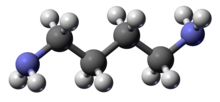This is an old revision of this page, as edited by CheMoBot (talk | contribs) at 13:56, 20 January 2011 (Updating {{chembox}} (no changed fields - added verified revid - updated 'UNII_Ref', 'KEGG_Ref') per Chem/Drugbox validation (report errors or [[user talk). The present address (URL) is a permanent link to this revision, which may differ significantly from the current revision.
Revision as of 13:56, 20 January 2011 by CheMoBot (talk | contribs) (Updating {{chembox}} (no changed fields - added verified revid - updated 'UNII_Ref', 'KEGG_Ref') per Chem/Drugbox validation (report errors or [[user talk)(diff) ← Previous revision | Latest revision (diff) | Newer revision → (diff) | |
 | |
| Names | |
|---|---|
| IUPAC name butane-1,4-diamine | |
| Other names 1,4-diaminobutane | |
| Identifiers | |
| CAS Number | |
| 3D model (JSmol) | |
| ChEMBL | |
| ChemSpider | |
| ECHA InfoCard | 100.003.440 |
| IUPHAR/BPS | |
| KEGG | |
| MeSH | Putrescine |
| PubChem CID | |
| CompTox Dashboard (EPA) | |
InChI
| |
SMILES
| |
| Properties | |
| Chemical formula | C4H12N2 |
| Molar mass | 88.1516 |
| Melting point | 27 °C |
| Boiling point | 158–160 °C |
| Except where otherwise noted, data are given for materials in their standard state (at 25 °C , 100 kPa).
| |
Putrescine (sometimes spelled putrescin) is a foul-smelling organic chemical compound NH2(CH2)4NH2 (1,4-diaminobutane or butanediamine) that is related to cadaverine; both are produced by the breakdown of amino acids in living and dead organisms and both are toxic in large doses. The two compounds are largely responsible for the foul odor of putrefying flesh, but also contribute to the odor of such processes as bad breath and bacterial vaginosis. They are also found in semen and some microalgae, together with related molecules like spermine and spermidine.
History
Putrescine and cadaverine were first described in 1885 by the Berlin physician Ludwig Brieger (1849-1919).
Production
Putrescine is produced on industrial scale by hydrogenation of succinonitrile, which is produced by addition of hydrogen cyanide to acrylonitrile. Putrescine is reacted with adipic acid to yield the polyamide Nylon-4,6, which is marketed by DSM under the trade name Stanyl.
Biotechnological production of putrescine from renewable feedstock is a promising alternative to the chemical synthesis. A metabolically engineered strain of Escherichia coli that produces putrescine at high titer in glucose mineral salts medium has recently been described. Cite error: The <ref> tag has too many names (see the help page).
Biochemistry
Putrescine attacks decarboxylated s-adenosyl methionine and converts it to spermidine. Spermidine in turn attacks another decarboxylated s-adenosyl methionine and converts it to spermine.
Putrescine is synthesized in small quantities by healthy living cells by the action of ornithine decarboxylase. The polyamines, of which putrescine is one of the simplest, appear to be growth factors necessary for cell division.
Toxicity
Putrescine is toxic in large doses. In rats it had a fairly low acute oral toxicity of 2000 mg/kg body weight.
References
- Haglund, William (1996). Forensic taphonomy: The Postmortem Fate of Human Remains. CRC Press. p. 100. ISBN 0849394341.
- Lewis, Robert Alan (1998). Lewis' Dictionary of Toxicology. CRC Press. p. 212. ISBN 1566702232.
- Kamhi, Ellen, Ph.D., RN, HNC (2007). Alternative Medicine Magazine's Definitive Guide to Weight Loss. Celestial Arts. p. 14. ISBN 1587612593.
Ornithine is converted by bowel bacteria into a toxic substance called putrescine, which in turn degrades into polyamines, such as spermadine, spermine, and cadaverine (literally meaning "the essence of dead cadavers").
{{cite book}}: CS1 maint: multiple names: authors list (link) - Ludwig Brieger, "Weitere Untersuchungen über Ptomaine" (Berlin, Germany: August Hirschwald, 1885), page 43. From page 43: Ich nenne dasselbe Putrescin, von putresco, faul werden, vermodern, verwesen. (I call this "putrescine", from putresco, to become rotten, decay, rot.)
- Ludwig Brieger, "Weitere Untersuchungen über Ptomaine" (Berlin, Germany: August Hirschwald, 1885), page 39.
- Brief biography of Ludwig Brieger (in German).
- "Nitriles". Ullmann's Encyclopedia of Industrial Chemistry (7th Ed. ed.). Retrieved 2007-09-10.
{{cite encyclopedia}}:|edition=has extra text (help) - "DSM Engineering Plastics". Retrieved 2007-09-10.
- Acute and subacute toxicity of tyramine, spermidine, spermine, putrescine and cadaverine in rats